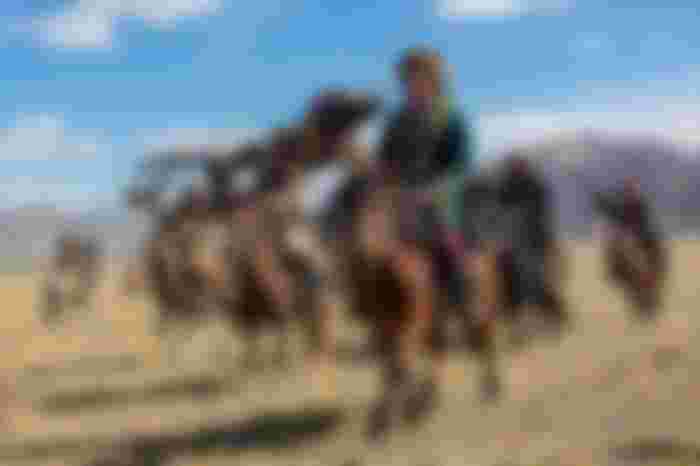We have all heard the name of the Eurasian steppe. Located in the middle of Europe and Asia, this vast grassland has a history of thousands of years. How many civilizations or empires have risen around this step, and how many civilizations or empires have been destroyed like straw!
Steps are basically a kind of eco-zone. Naturally hilly shrubs, temperate grasslands, savannas and vast wildlife areas are called steppe. This vast area on the banks of rivers or lakes is completely covered with greenery.
Usually not too many trees grow in this area. In the steppe region the external conditions change mainly with the weather. Sometimes partially desert, sometimes covered with grass and green. The soil in this region is usually humus-rich and black.
We almost see Steppe in Hollywood movies. In the glittering blue sky, white clouds are touching the green sheet lying in the distant mountains! Several parts of the famous TV series Game of Thrones have been filmed across a wide range of Bulgaria.

The Eurasian steppe is also called the Great steppe. It extends from Bulgaria, Romania, Moldova via Ukraine to Russia, Kazakhstan, China's Xinjiang and Mongolia to Manchuria. Most of the Pannonian steppe is located in Hungary.
Since the Paleolithic era, the Eurasian steppe has led to economic, political, cultural and commercial development in Eastern Europe, Central Asia, South Asia, East Asia, and the Middle East. This steppe not only developed civilizations during the prehistoric and medieval times, but also centered around the Eurasian steppe-belt, which formed the modern era and now the European economic and cultural foundation.
The Eurasian steppe is associated with the rise and fall of many nations and their cultural heritage. There are many civilizations involved.
The Eurasian steppe was the place of origin and cultural pilgrimage of many nomadic empires and tribal kingdoms of history, including Jiangnu, Scythia, Simeria, Saramatia, Hanik Empire, Corasmia, Sogdiana, Gianbi, Mongolian. The steppe stretched for thousands of miles from the source of the Danube to the Pacific Ocean.
Geographical location
To the north it was bounded by the European part of Russia, some parts of Asia, and the vast forests of Siberia. And to the south is a vast warm meadow. In fact, there is no clear border in the south. This step, which stretches for several thousand miles, has shrunk to two points. In that sense, the Eurasian steppe can be divided into three mainlands.

1. West Step
The western part is called the Pontic Caspian steppe. It stretches from the Danube coast to Kazan, Russia, and to the southeast of the Ural Mountains. The Caspian steppe stretched southeast between the Black Sea and the Caspian Sea to the Caucasus Mountains.
The northern part of the Pontic Caspian steppe was rich in vast forests. At present this forest land has been cleared and converted into completely fertile agricultural land. The Caspian steppe is separated from the main steppe by the Great Hungarian Plain to the west.
Some of the coastal steppes of the Crimean peninsula on the north shore of the Black Sea are connected with the original Caspian steppes. This part deals with the history of several civilizations that developed in the Mediterranean basin.
2. Central step
The central steppe is called the Kazakh steppe. To the south it is a desert and is interrupted by two famous rivers, the Amu Darya or the Oxus and the Siri Darya or the Jacqueline. The two rivers that fall into the Aral Sea are very important for agriculture and irrigation in the region. To the southeast are the densely populated Fergana Valley, and to its west are the historic cities of Tashkent, Samarkand, and Bokhara, on the banks of the Jerushan River.

3. East step
This part is spread across China's Xinjiang province and Mongolia. To the west, Zanzibar is bounded by the Tarabagatai Mountains. At the edge of Georgia is the desert. However, there is also vast green and grassland around the desert. This step is associated with Mongolian civilization. This place was the mainstay of Genghis Khan's invasion of the West.
This area is a bit dry and warm. However, rivers flowing down from the surrounding hills play a very important role in agriculture and irrigation. The surrounding cities became economically and commercially important based on these rivers at that time.
History
The history of this region is as vast as it is vast. Horses are very popular in this region as it is a vast plain. Numerous wars, cultures and civilizations are involved in the history of the rise and fall centered on this step. The rise of the Mongol Empire was based on this step. Troops from various neighboring states often clashed with nomads in the region.

At that time there was no permanent community living in this area. Those who lived were nomads or tribals. Disputes arose between the surrounding states over the occupation of the region. In most cases, when the Chinese sent troops to Mongolia, the nomads fled. Because they were relatively few in number.
There were also various obstacles to the gathering of the nomads scattered throughout the steppe. Conflicts between them over the possession of agricultural land and the theft of livestock seemed to be a daily occurrence.
The nomads were highly respected by the wild tribes of the northern frontier. Later, the tribes merged with the Kazakh people in the south. Since then, there have been clashes between tribes and nomads over occupation of agricultural land and looting of livestock.
From the very beginning of history there was a great conflict between Mongolia and the Chinese. They often fought. And as many battlefields as there are, they were all within this vast step.
The Mongolian steppe, which belongs to the Eurasian steppe, is the most involved in history. Because there have been innumerable bloody wars over the conflict in this region. Temujin was born in the fire of these conflicts. One kingdom after another continues to be conquered through war and destruction. In the pages of history, his name was changed to 'Genghis Khan'.
At present the Mongolian government has erected a giant sculpture on the Mongolian steppe in memory of Genghis Khan. Russian culture is also heavily influenced by steppe nomads and Asian nomads.

The famous Tengriism in the region was introduced by the Turkish-Mongol nomads. At that time Nestorianism and Manchesterism spread to the Tarim Basin and China. However, they never became the established majority religion of the region.
It then spread from northern India to the Tarim Basin and became a pilgrimage site to Buddhism and China. After that Islam gradually spread in that region. By about 1400 AD, the entire steppe west of Janjuria had come under the shadow of Islam. Islam was established in the Tarim Basin around 1600 AD. It was then influenced by Tibetan Buddhism in Zanzibar and Mongolia.
All in all, the name of the Eurasian steppe is entangled in the pages of history. As important as this step is in the development of civilization and culture, it is no less important commercially.





Nice article, well researched. I am writing an article to be published about Xinjiang. I will put a link here for people to learn more about the geography of the region. Thanks.